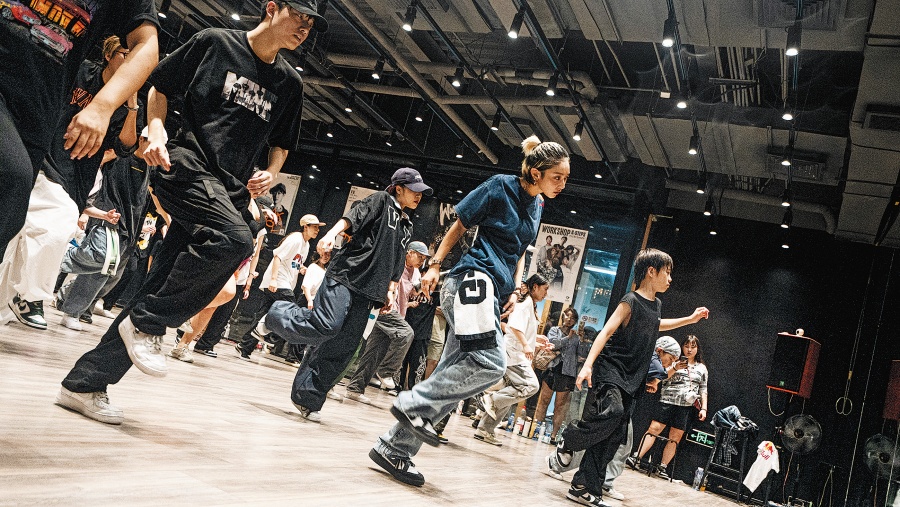(ANN/CHINA DAILY) – Once seen as a distraction from his studies, Fan Xiaoyu’s passion for street dance has now made him the owner of G-Steps Dance Studio, one of China’s largest dance schools with over 30 branches in Beijing and 150,000 students trained.
“I never imagined my love for dance would resonate with so many people,” Fan said. Today, street dance is thriving in China’s urban centres, offering young professionals a creative escape from their demanding work lives.
For many young workers, the day begins with the grind of a typical office environment — emails to answer, reports to generate, and endless meetings to attend. These professionals often spend long hours in front of screens.
Don’t stop believing
Fan was no exception. In 2013, he started working at an internet company in Beijing. He had earlier moved from Baoshan, Yunnan province, to the capital city to study business administration at college.
After the company shifted to a new building, Fan discovered a spacious yoga room with mirrors lining the walls that the company had prepared for its employees.
“When I saw the room, I instantly associated it with a space for dancing. Then I started dancing in front of the mirrors, and soon people who shared the same interests came and we danced together,” recalled Fan.
In four years, Fan gathered together about 500 of the internet company employees to participate in the informal dance groups.

The company, which has about 10,000 employees, supported Fan’s idea and hired more dance teachers to give classes every day after work.
One of the teachers was Wang Xiao, who was also from Yunnan and who had learned to dance as a child.
“I can still recall the first class. I taught those who had never received dance training before. They found it hard and followed my moves reluctantly,” recalled Wang, now an experienced G-Steps instructor.
In 2017, Fan launched his first dance studio near Beijing’s 798 Art Zone. His colleagues and bosses questioned his decision to become an entrepreneur, but Fan was determined.
Fan named his dance studio “G-Steps”, after a dance club he started when he was a high school student. He described the venture as “rediscovering and returning to what I love”.
Drawing inspiration from stars like Michael Jackson, whose unique dance style fused pop, funk, soul and hip-hop, as well as from K-pop groups, Fan started dancing as a teenager because it “made me feel cool”.
Urban roots
With diverse movements and rhythmic music, dance intrigues most people.
Young Chinese professionals have embraced a number of dance styles such as contemporary, Chinese folk, and classic Chinese dance, but street dance is the most enjoyable one for amateurs and beginners, Fan believes.
“Compared with other dance forms, like ballet and classic Chinese dance, street dance is easy to learn, makes individuals overcome their fears and builds confidence,” he said. “It also promotes mindfulness and helps individuals to stay mentally focused.”
Fan said the development of dance culture is closely linked to urbanisation.

“Regardless of background — whether an office worker who is a beginner or a seasoned dancer with years of experience — everyone possesses the same potential to dance. Young people are willing to invest in dance, marking a positive shift,” he said.
“The youngest student we have is about 4 years old and the eldest one is more than 60 years old. Dancing is a universal pleasure for people of all ages and occupations.”
“Dance transcends words, allowing us to express emotions and connect on a deeper level, showcasing the powerful resilience of the human spirit,” he said.
Dance me to the end
Hao Xin, 25, also finds joy in dancing, a hobby she started in college.
“After a long day of work, the freedom of dance provides me with a necessary outlet for stress relief. I enjoy the dance studio which is filled with the sounds of laughter and music.
It fosters a sense of community as these dancers bond over shared experiences, supporting each other’s growth and celebrating personal milestones,” said Hao, who works for an advertising company in Beijing.
Wang Jiatong fell in love with street dance when he was 13 while passing by a street dance studio in Hanzhong, Shaanxi province.
He believed it was one of the first dance studios of its kind in the small city, and he was deeply intrigued by the energetic music and an environment where he could express himself in a creative and unique way.
Wang came to Beijing to attend university, secured the advertising company job, worked hard, and tried to live the life he had dreamed of, but reality intervened.
“The office was dull and only the dancing made me feel alive,” said Wang, 34.
Last year, he returned to Xi’an, capital of Shaanxi province. Four months ago, he launched J-Dance studio, which offers street dance courses for enthusiasts.

“So far, we have more than 300 registered users, which is beyond my expectation,” Wang said.
“Unlike first-tier cities, such as Beijing and Shanghai, street dance studios like ours are still a growing trend in Xi’an. But the first month after the studio opened we received warm feedback from the users,” he said.
Compared with dance studios from about 10 years ago, which attracted professional and aspiring professional dancers, dance studios are nowadays popular with amateurs, he said.
The dance studio has become a sanctuary where young people can reclaim their identities beyond their job titles, he said.
“Ninety percent of our clients are young women who are white-collar workers, full-time mothers, and young students,” said Wang.
“They enjoy the atmosphere in the dance studio. From the outfits to the makeup, they show great interest and passion when they appear in the dance studio, showcasing themselves in front of the mirrors.”





